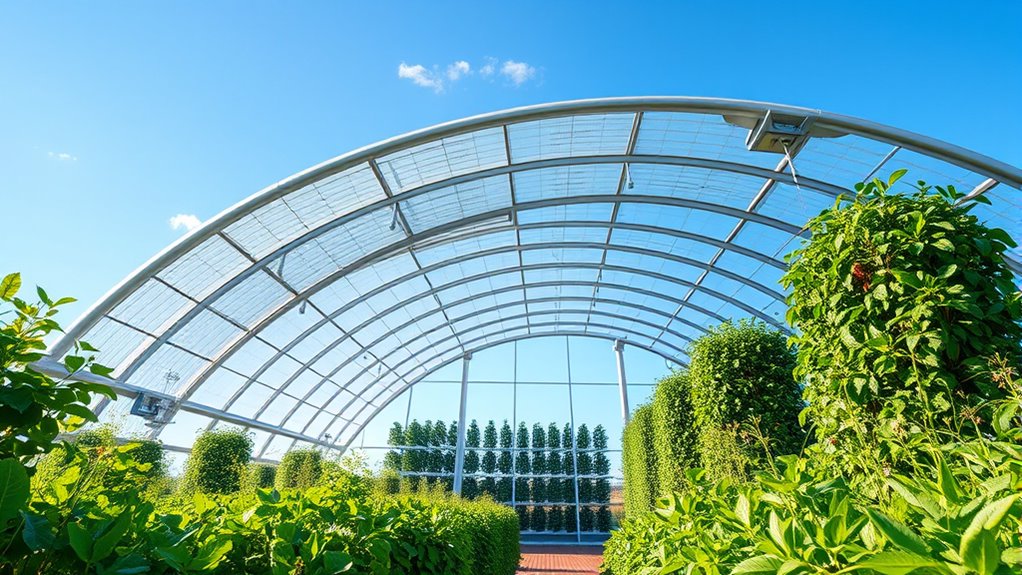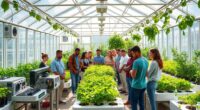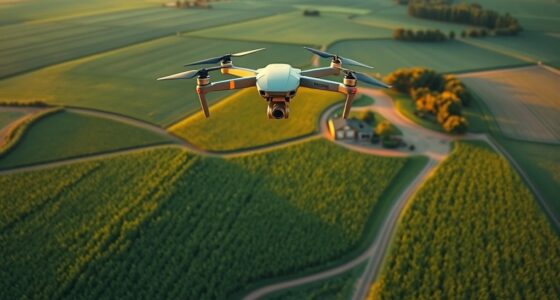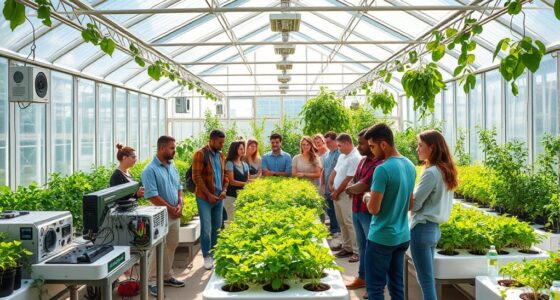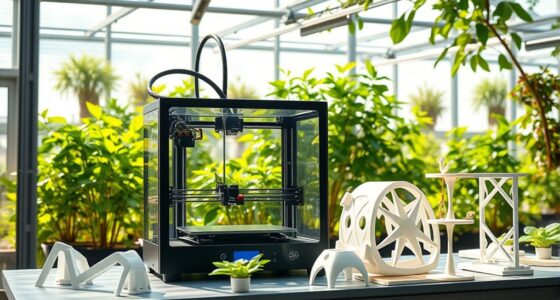The future of greenhouse tech looks promising, with innovations like vertical farming that maximize space and crop yields in urban areas. Renewable energy sources such as solar and wind will power eco-friendly operations, reducing costs and carbon footprints. Expect smarter greenhouses equipped with sensors and AI for precise climate control and crop management. Advanced materials will boost efficiency, while genetically tailored crops will enhance resilience. Staying ahead means exploring these exciting trends shaping agriculture’s next chapter.
Key Takeaways
- Vertical farming will become more prevalent, maximizing urban space and enabling year-round crop production.
- Increased integration of renewable energy sources will make greenhouses energy-positive and more sustainable.
- Advanced materials will improve insulation and light diffusion, reducing energy consumption and enhancing crop growth conditions.
- Automation and AI will optimize environmental controls, reducing labor and minimizing resource waste.
- Crop genetic innovations and data-driven strategies will enhance resilience, yield, and adaptability to changing climates.

Are you curious about how technology is transforming greenhouse farming? The future holds exciting advancements that will reshape how we grow food sustainably and efficiently. One of the most promising trends is vertical farming, which involves stacking crops in controlled environments, maximizing space, and reducing land use. This method allows you to grow more produce in smaller footprints, making it perfect for urban areas where space is limited. Vertical farming also enables precise control over environmental factors such as light, temperature, and humidity, leading to higher yields and better quality crops all year round. As technology advances, you’ll see more automated systems managing these vertical farms, reducing labor costs and minimizing errors. Combining vertical farming with renewable energy sources further enhances sustainability. Solar panels, wind turbines, and other renewable options are increasingly integrated into greenhouse designs, cutting down reliance on fossil fuels and lowering operational costs. This synergy means your farm can operate more independently and eco-friendly, even in regions with limited traditional energy supply. Expect to see a shift toward energy-positive greenhouses that generate more power than they consume, powering LED grow lights, climate control systems, and automation tools. These innovations will make your farming endeavors more resilient and cost-effective over time. Additionally, leveraging renewable energy sources such as solar and geothermal energy will significantly boost the overall efficiency and sustainability of your operation. Incorporating energy storage systems can further ensure consistent power supply, especially during periods of low renewable energy generation. Moreover, advancements in greenhouse materials will improve insulation and light diffusion, enhancing crop growth conditions and reducing energy needs. Innovations in sustainable building materials are also contributing to lower environmental impacts of greenhouse structures. Continuous research into biodegradable and eco-friendly materials promises to reduce the ecological footprint of future greenhouse constructions. The next decade will also see significant improvements in automation and smart technology. Sensors and IoT devices will continuously monitor conditions inside your greenhouse, providing real-time data to optimize watering, lighting, and nutrient delivery. Artificial intelligence will analyze this data, predicting issues before they become problems and adjusting systems automatically for best growth. This level of automation minimizes waste and maximizes efficiency, allowing you to focus more on strategic decisions rather than routine tasks. Furthermore, advancements in crop genetics and precision agriculture will enable you to cultivate varieties specifically designed for controlled environment growth, increasing resistance to pests and diseases while improving yields. Data-driven insights will help you select the best crop types for your specific climate and market demands, ensuring profitability and sustainability. As these trends develop, you’ll find that greenhouses become more integrated with renewable energy infrastructure, further reducing environmental impact. With cleaner energy sources, your greenhouse can operate with a smaller carbon footprint. The combination of vertical farming, renewable energy, automation, and smart technology will make your greenhouse more adaptable, productive, and sustainable. These innovations will not only benefit your bottom line but also contribute positively to global efforts for food security and environmental preservation. The future of greenhouse tech is bright, and embracing these trends now will position you at the forefront of sustainable agriculture in the coming decade.
Frequently Asked Questions
How Will AI Influence Greenhouse Climate Control?
AI will notably enhance greenhouse climate control by enabling precise AI optimization of environmental conditions. You’ll benefit from advanced climate modeling that predicts and adjusts temperature, humidity, and light levels in real-time, creating ideal growing conditions. This technology reduces resource waste, increases yields, and improves plant health, all while making your greenhouse operations more efficient. As AI continues to evolve, expect even smarter systems that adapt seamlessly to changing environmental factors, ensuring consistent crop quality.
What Are the Latest Sustainable Energy Sources for Greenhouses?
You’re exploring sustainable energy sources for greenhouses, and two options stand out: solar thermal systems and biogas digesters. Solar thermal harnesses sunlight to heat your greenhouse efficiently, reducing reliance on fossil fuels. Biogas digesters convert organic waste into renewable energy, providing both heat and power. By adopting these technologies, you can lower your environmental impact, cut costs, and create a more sustainable, eco-friendly growing environment.
How Will Automation Impact Greenhouse Labor Requirements?
They say “a stitch in time saves nine,” and automation in greenhouses proves this true. You’ll see improved labor efficiency as machines handle repetitive tasks, reducing staffing needs. Automation allows you to refine staffing strategies, focusing on skilled workers for complex jobs. This shift means you can operate more sustainably and cost-effectively while maintaining ideal conditions, ultimately transforming how you manage greenhouse labor in the years ahead.
What Are the Biggest Cybersecurity Concerns for Smart Greenhouses?
You should be aware that smart greenhouses face major cybersecurity concerns like data privacy and cyber attack prevention. Hackers may target control systems, risking crop damage or data breaches. To protect your greenhouse, implement strong security measures such as encryption, regular software updates, and access controls. Staying vigilant helps prevent cyber attacks and keeps your data safe, ensuring your smart greenhouse runs smoothly and securely.
How Will Biotech Advances Improve Crop Resilience in Greenhouses?
Biotech advances will markedly boost crop resilience in your greenhouses through genetic modification, making plants more resistant to pests and diseases. You’ll see improved pathogen resistance, reducing the need for chemical treatments and increasing yields. These innovations help your crops withstand environmental stresses, ensuring consistent production. As biotech progresses, you’ll benefit from stronger, healthier plants that thrive in controlled environments, ultimately enhancing your greenhouse’s efficiency and sustainability.
Conclusion
As you look ahead, the future of greenhouse technology promises innovation and sustainability, transforming agriculture for the better. Yet, amid these advancements, challenges like climate change and resource management remain. It’s a delicate balance—embracing cutting-edge solutions while safeguarding our environment. By staying informed and adaptable, you can be part of this exciting evolution, shaping a greener, more resilient future where technology and nature work hand in hand. The next decade holds endless possibilities—are you ready to lead the change?
